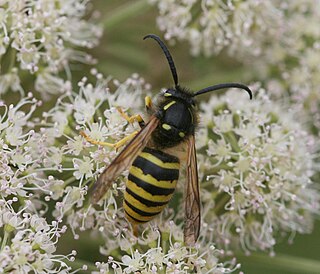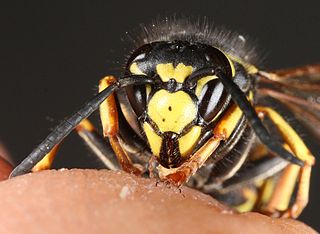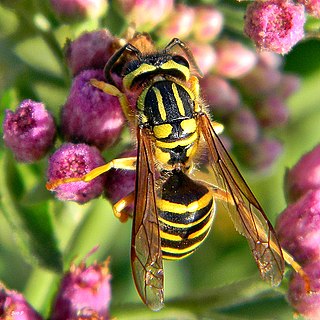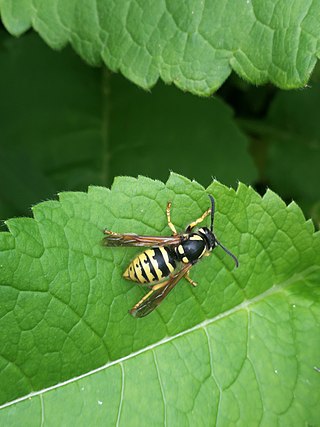Related Research Articles

Parasitism is a close relationship between species, where one organism, the parasite, lives on or inside another organism, the host, causing it some harm, and is adapted structurally to this way of life. The entomologist E. O. Wilson characterised parasites as "predators that eat prey in units of less than one". Parasites include single-celled protozoans such as the agents of malaria, sleeping sickness, and amoebic dysentery; animals such as hookworms, lice, mosquitoes, and vampire bats; fungi such as honey fungus and the agents of ringworm; and plants such as mistletoe, dodder, and the broomrapes.

Trophallaxis is the transfer of food or other fluids among members of a community through mouth-to-mouth (stomodeal) or anus-to-mouth (proctodeal) feeding. Along with nutrients, trophallaxis can involve the transfer of molecules such as pheromones, organisms such as symbionts, and information to serve as a form of communication. Trophallaxis is used by some birds, gray wolves, vampire bats, and is most highly developed in eusocial insects such as ants, wasps, bees, and termites.

Kleptoparasitism is a form of feeding in which one animal deliberately takes food from another. The strategy is evolutionarily stable when stealing is less costly than direct feeding, such as when food is scarce or when victims are abundant. Many kleptoparasites are arthropods, especially bees and wasps, but including some true flies, dung beetles, bugs, and spiders. Cuckoo bees are specialized kleptoparasites which lay their eggs either on the pollen masses made by other bees, or on the insect hosts of parasitoid wasps. They are an instance of Emery's rule, which states that insect social parasites tend to be closely related to their hosts. The behavior occurs, too, in vertebrates including birds such as skuas, which persistently chase other seabirds until they disgorge their food, and carnivorous mammals such as spotted hyenas and lions. Other species opportunistically indulge in kleptoparasitism.

Brood parasitism is a subclass of parasitism and phenomenon and behavioural pattern of certain animals, brood parasites, that rely on others to raise their young. The strategy appears among birds, insects and fish. The brood parasite manipulates a host, either of the same or of another species, to raise its young as if it were its own, usually using egg mimicry, with eggs that resemble the host's.

Dolichovespula is a small genus of social wasps distributed widely throughout the Northern Hemisphere. The yellow and black members of the genus are known by the common name yellowjackets in North America, such as Dolichovespula norwegica, along with members of their sister genus Vespula. In a study on the nesting biology of Dolichovespula, a colony of D. maculata with 771 workers was reported as having the largest recorded population count.

Polyergus breviceps is a species of ant endemic to the United States. It is a social parasite of other ants, namely of Formica gnava but also of Formica occulta and Formica argentea. Polyergus is an inquiline parasite, having lost its ability to take care of its young and themselves. "The workers do not forage for food, feed the young or the queen, or even clean up their own nest". To survive, Polyergus workers raid Formica nests to steal the pupae—which, once hatched, become workers of the mixed nest. This sort of relationship is not unique, of the approximately 8,800 species of ants, at least 200 have evolved some form of symbiotic relationship with one another. What makes Polyergus special is the way a newly mated queen can, all by herself, take over a Formica nest and start a new colony.

A wasp is any insect of the narrow-waisted suborder Apocrita of the order Hymenoptera which is neither a bee nor an ant; this excludes the broad-waisted sawflies (Symphyta), which look somewhat like wasps, but are in a separate suborder. The wasps do not constitute a clade, a complete natural group with a single ancestor, as bees and ants are deeply nested within the wasps, having evolved from wasp ancestors. Wasps that are members of the clade Aculeata can sting their prey.

The eastern yellow jacket or eastern yellowjacket is a wasp found in eastern North America. Although most of their nests are subterranean, they are often considered a pest due to their nesting in recreational areas and buildings. This yellow jacket is a social insect, living in colonies of hundreds to thousands of individuals. Along with their subfamily, Vespinae, this species demonstrates supportive parental care for offspring, separation of reproductive and sterile castes, and overlapping generations. They aggressively defend their hives from threats and are known to inflict painful stings.

Dermanyssoidea is a superfamily of mites, including most of the mites which parasitise vertebrates.

Dolichovespula saxonica, also known as the Saxon wasp, is a common social wasp found in the Palearctic region, specifically in large parts of Europe and in northern and central Asia. Although originally from continental Europe, D. saxonica has since colonised Britain, mainly in the south and east, but has been recorded as far north as East Lothian, Scotland. Most of their nests are above ground in trees and bushes, but they can also be found in buildings. Due to the proliferation of nests in urban areas and near residential homes, D. saxonica can be a pest for people. As a result, many human interventions are in place to remove Saxon nests. D. saxonica has been found to use chemical signaling in a lot of behaviours, such as alarm calls, fertility cues, and chemical trails.

The Norwegian wasp is a species of eusocial wasp. It is common in Scandinavia and can also be found in Scotland and other areas in Britain and Ireland. Often known for being a tree wasp, it nests in low branches and bushes and feeds on insects. It also obtains nectar from blueberry and snowberry flowers. Although D. norwegica is rarely considered a pest in the past, a few cases of pest problems relating to them have been reported. The species is not endangered.

The tree wasp is a species of eusocial wasp in the family Vespidae, found in the temperate regions of Eurasia, particularly in western Europe. Despite being called the tree wasp, it builds both aerial and underground paper nests, and can be found in rural and urban habitats. D. sylvestris is a medium-sized wasp that has yellow and black stripes and a black dot in the center of its clypeus. It is most common to see this wasp between May and September during its 3.5 month colony cycle.

Dolichovespula adulterina is a species of parasitic social wasp found in the Palearctic region. D. adulterina feeds on a variety of foods, including insects, spiders, arthropods, meat, molluscs, fruit, nectar, and larval secretions. D. adulterina was formerly considered to be synonymous with D. arctica from the Holarctic region, but more recent research indicates that D. arctica is a separate species.

Vespula austriaca is an obligate parasitic wasp, parasitizing the nests of other species in the genus Vespula in the Old World. Its common host species include V. rufa in Europe, Japan, and East Siberia.V. austriaca wasps pollinate orchids.

Vespula squamosa, or the southern yellowjacket, is a social wasp. This species can be identified by its distinctive black and yellow patterning and orange queen. This species is typically found in eastern North America, and its territory extends as far south as Central America. Within these territories, they create enormous, multiple-comb nests. The colonies may be either annual or perennial depending on the climate, and in many perennial nests, polygyny takes place. In addition, this species uses pheromones both as a sexual attractant and an alarm signal. This species feeds on insects and animal carcasses; it does not produce honey. V. squamosa, a social insect, has developed a parasitic relationship with the species V. vidua and V. maculifrons. Due to their painful, venomous stings, the species is considered a pest.

Dolichovespula arenaria, also known as the common aerial yellowjacket, sandhills hornet, and common yellow hornet, is a species of wasp within the genus Dolichovespula widely distributed in the North American continent.

Polistes atrimandibularis is one of four obligate social parasites among the Polistes wasps found in Europe. Of the four social paper wasp parasite species known, it is the smallest. It parasitizes multiple species such as P. dominula, P. nimpha, P. associus, P. gallicus, and P. biglumis. Females of P. atrimandibularis are unable to build a nest or produce workers, and therefore rely entirely on the host colony.
Bombus inexspectatus is an endangered species of bumblebee native to Europe.

Nest usurpation is when the queen of one species of eusocial insects takes over the colony of another species.

Dolichovespula omissa is a species of wasp in the family of Vespidae. It lives as a social parasite by letting colonies of Dolichovespula sylvestris raise their young.
References
- 1 2 Richard Deslippe (2010). "Social Parasitism in Ants". Nature Education Knowledge. Retrieved 2010-10-29.
In 1909, the taxonomist Carlo Emery made an important generalization, now known as Emery's rule, which states that social parasites and their hosts share common ancestry and hence are closely related to each other (Emery 1909).
- ↑ Emery, C. "Über den Ursprung der dulotischen, parasitischen und myrmekophilen Ameisen". Biologisches Centralblatt29, 352–362 (1909)
- ↑ Carpenter, J. M., & Perera, E. P. (2006). Phylogenetic relationships among yellowjackets and the evolution of social parasitism (Hymenoptera: Vespidae, Vespinae). American Museum Novitates, 1–19.
- ↑ Dvořák, L. (2007). Parasitism of Dolichovespula norwegica by D. adulterina (Hymenoptera: Vespidae). Archived 2016-03-04 at the Wayback Machine Silva Gabreta, 13(1) 65–67.
- ↑ Wenseleers, Tom (2011). "Intraspecific queen parasitism in highly eusocial bee" (PDF). Biology Letters. 7 (2). Royal Society Publishing: 173–176. doi:10.1098/rsbl.2010.0819. PMC 3061179 . PMID 20961883 . Retrieved 9 July 2011.
- ↑ Hines, H. M., & Cameron, S. A. (2010). The phylogenetic position of the bumble bee inquiline Bombus inexspectatus and implications for the evolution of social parasitism. Insectes Sociaux, 57(4), 379–383.
